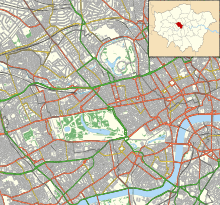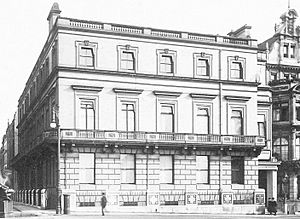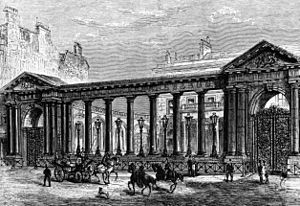Park Lane facts for kids
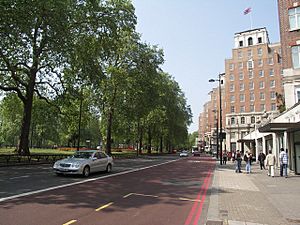
Looking north on Park Lane. Hyde Park is to the left; the Grosvenor House Hotel to the right.
|
|
| Former name(s) | Tyburn Lane |
|---|---|
| Part of | A4202 |
| Namesake | Hyde Park, London |
| Maintained by | Transport for London |
| Length | 0.7 mi (1.1 km) |
| Location | City of Westminster, Central London |
| Postal code | W1 |
| Nearest Tube station |
|
| Coordinates | 51°30′32″N 0°09′18″W / 51.508888°N 0.155129°W |
| Construction | |
| Inauguration | 1741 |
| Other | |
| Known for |
|
Park Lane is a very important road in Central London, England. It is located in the City of Westminster. This famous street runs from Hyde Park Corner in the south to Marble Arch in the north. Park Lane separates the beautiful Hyde Park on its west side from the fancy Mayfair area on its east side.
Over the years, many important buildings and luxury hotels have been built here. Park Lane has always been one of London's most popular streets. Even though it's a busy road, it remains a very desirable place to live.
Contents
Where is Park Lane Located?
Park Lane is about 0.7 miles (1.1 kilometers) long. It stretches north from Hyde Park Corner to Marble Arch. The road runs along the eastern edge of Hyde Park. To its east is the well-known area of Mayfair. Park Lane is a main road, officially called the A4202.
Getting Around Park Lane
Park Lane is a key route for buses in Central London. Many bus routes use this road, including 2, 10, 16, 36, 73, 74, 82, 137, 148, 414, and 436. There are also night bus routes like N16, N73, N74, and N137.
The closest tube stations are Hyde Park Corner. This station is on the Piccadilly line near the south end of Park Lane. Marble Arch station is on the Central line near the north end. At Brook Gate, there is a special crossing for people and cyclists. This crossing connects Hyde Park to London Cycle Route 39. This route is great for cycling from the park to the West End.
History of Park Lane
Early Days of Park Lane
What we now call Park Lane was once just a simple path. It ran along the edges of farms. When Hyde Park opened in the 1500s, this path became the eastern border of the park. It stretched from Piccadilly to Marble Arch.
In the 1700s, the road was known as Tyburn Lane. A tall brick wall separated it from Hyde Park. There were only a few houses along the lane at that time. In 1741, a group called the Kensington Turnpike Trust started taking care of the road. This was because many coaches were using it, causing the road surface to wear out.
Growing Popularity in the 1800s
Park Lane became much more important after 1820. This was when Decimus Burton built Hyde Park Corner at the south end of the lane. At the same time, the entrances to Hyde Park were improved. The park's old brick wall was replaced with iron fences.
After these changes, Park Lane became a very popular place to live. It offered amazing views across Hyde Park. It was also located at the most fashionable western edge of London. Many wealthy families wanted to build their homes here. The Grosvenor Estate, which owned much of the land, encouraged building large family houses.
Some of the biggest private mansions in London were built on Park Lane. These included Grosvenor House and Dorchester House. Famous people lived on the street. For example, Benjamin Disraeli, who later became the British Prime Minister, lived at No. 93. The kind person Moses Montefiore lived at No. 90 for over 60 years. A special blue plaque marks his old home.
Londonderry House was another important mansion on Park Lane. It was bought by a British aristocrat in 1819. During World War I, it was used as a military hospital. Later, after World War II, the house was sold. The 29-story London Hilton on Park Lane hotel was built in its place. This hotel opened in 1963.
Park Lane in the 1900s
In the early 1900s, Park Lane started to change. People living in the grand houses began to complain about the noise from cars and buses. The first flats (apartments) were built on the street in 1915. Shops also started to appear. However, many buildings were rebuilt to include penthouse flats, which became very popular.
The famous dancing duo, Fred and Adele Astaire, lived in a penthouse flat at No. 41 in 1923. They stayed there while performing in London's West End.

The Marriott London Park Lane hotel opened in 1919. The Dorchester hotel, designed by Sir Owen Williams, opened on Park Lane in 1931. It quickly became known as a very luxurious hotel. It was a favorite spot for many writers and artists. From World War II onwards, the hotel became famous for hosting international film stars.
During World War II, some buildings on Park Lane were damaged by bombs. However, the strong construction of The Dorchester hotel made it a safe place. General Dwight D. Eisenhower even made it his headquarters in 1942.
The London Hilton on Park Lane began construction in 1960 and opened in 1963. It cost a lot of money to build. In 1993, special gates were put up at the south end of Park Lane. These gates honor Queen Elizabeth The Queen Mother.
Park Lane Today (2000s)
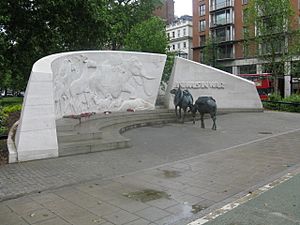
In 2004, the Animals in War Memorial was opened on Park Lane. This memorial remembers animals that served in wars alongside people.
Park Lane still attracts famous residents. In 2002, Robert B. Sherman, who wrote music for Chitty Chitty Bang Bang and Mary Poppins, moved to an apartment on Park Lane. He loved the views of Hyde Park. The successful businessman Mohamed Al-Fayed has offices on Park Lane.
Property prices on Park Lane are still among the highest in London. Many of the hotels and businesses on Park Lane today are owned by wealthy people from the Middle East and Asia. For example, The Dorchester hotel was bought by the Sultan of Brunei in 1985. It is now part of the Dorchester Collection, which owns other luxury hotels around the world.
Images for kids
-
Park Lane was updated between 1960 and 1963. This included moving traffic closer to Apsley House.
See also
 In Spanish: Park Lane para niños
In Spanish: Park Lane para niños


